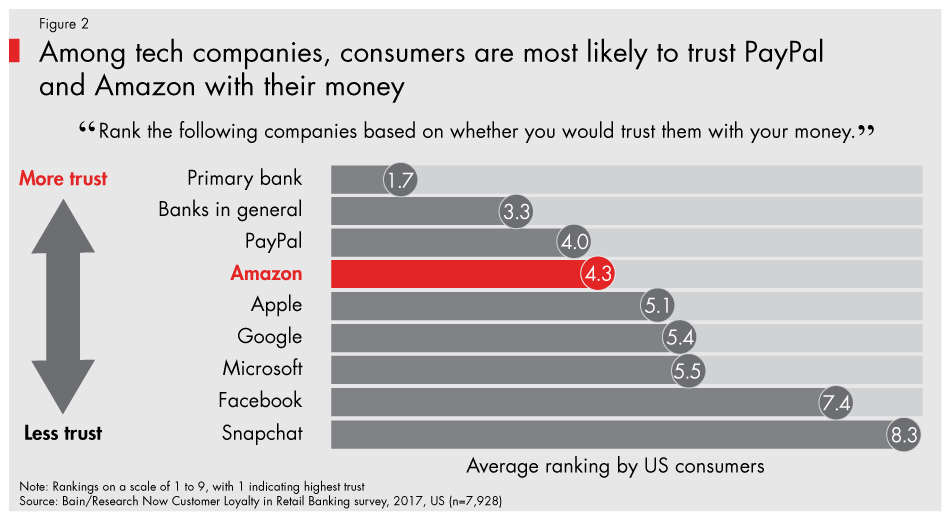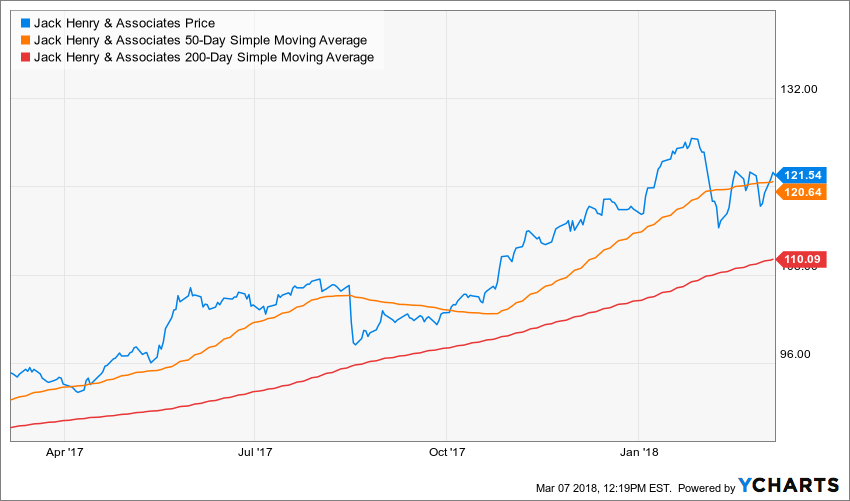Bezos' Latest Bet: Consumers Want to Bank With Amazon
Amazon.com (AMZN) is at it again. The online retail giant has another target in its sites. Let the worry … and disruption … begin.
This week, The New York Times reported Amazon.com executives have held talks with JPMorgan (JPM) about a white-label checking account service.
If you’re an executive at a regional financial institution, it is time to pay attention.
This is not the first time analysts have wondered about Amazon’s banking ambitions. Financial services, or at least some customer-facing products, are a logical fit. The company has already taken control of many household purchasing habits. Getting the banking too would be a no-brainer.
Last year, McKinsey & Co., a global consulting company, began telling financial services clients that they should worry about Amazon.com. The consultancy noted that the Seattle retailer already had a substantial bank-like operation, and an army of Washington lobbyists.
In 2017, Bloomberg reported Amazon.com extended $3 billion worth of bridge loans to 20,000 merchants operating on its e-commerce platform.
The merchant program at Amazon.com is among the least well-understood aspects of its business. Jeff Bezos, the chief executive officer and founder, has noted that more than 100,000 Amazon.com merchants have revenues in excess of $100,000. It is a cottage industry hiding in plain sight.
Bezos and his managers are fostering its growth with loans.
They are not alone. PayPal Holdings (PYPL) and Square Inc. (SQ) have burgeoning small loan businesses, too. Like Amazon.com, they serve a part of the economy that has been largely neglected by regional bankers in an era of stifling regulation.
The jump to consumer financial services could be epic. It would give the biggest online retailer a direct link to its customers’ wallets.
The odds of consumers embracing such a service are very good.

Image credit: Bain & Co.
In a 2017 survey of 133,000 banking customers in 22 countries, interest was high for financial products offered by non-traditional banks. In the U.S., a solid 55% of respondents were open to buying these products from established technology companies.
The key is service. From day one, Bezos forged a relationship with Amazon.com customers built on service. He even forced new executive managers to cut their teeth in call centers. Other companies pay lip service to customer-first policies. At Amazon.com, it is the real deal.
And it is hard to argue with the results.
Amazon.com is continually ranked atop customer satisfaction surveys. Cowen & Co. analyst John Blackledge estimates that 80 million people like shopping at the site so much, they are willing to pay an annual subscription for the right. This group cuts across social, geographic and political boundaries.
Plus, they are loyal.
Related story: Tech Giants Set to Tackle the Healthcare Crisis
It is a good customer base for a bank. That should send shivers down the spine of small financial institution managers.
There is a silver lining, though. Most banking is local. Customers form relationships based on trust with their banks. That relationship gives community bankers a leg up. But they will have to act fast to maintain their competitive advantage.
For investors, this is an opportunity.
A 2017 report from PricewaterhouseCoopers found that 82% of incumbent financial institutions expected to increase partnerships with fintechs during the next 3-5 years. This is a tidal wave of new investment in the offing.
I have been telling my members about a small financial technology company called Jack Henry & Associates (JKHY). Hidden away in Monett, Mo., Jack Henry is not your typical fast-growing fintech. Executives built a thriving software business by serving the management and regulatory needs of 11,300 regional banks and credit unions.
As information technology progressed, the business grew into other facets. Today, the company builds mission-critical customer and business information services, automation processes and valued-added features … like online banking.

Jack Henry managers understand that the future is mobile, and voice-activated.
Their software allows bank and credit union customers to use their smartphones to move money between accounts, pay bills and even deposit checks by snapping a photograph. In the future, they will be able to perform many of these functions by voice.
Recently, the company showed off a set of Alexa skills. The voice-activated software solution brings personal banking to Amazon.com Echo enabled devices.
The stock has enjoyed a steady trek higher since the 2009 lows at $14.29. Tuesday it closed at $121.90. That is a compound average gain of 18.6%. The forward price-to-earnings ratio is 30, and shares trade at 6.4 times sales. While neither ratio is especially cheap, they are not out of line, given the size of the opportunity.
Amazon.com is coming after regional banks. Customers, and fintechs like Jack Henry, are set to benefit.
Best wishes,
Jon D. Markman



